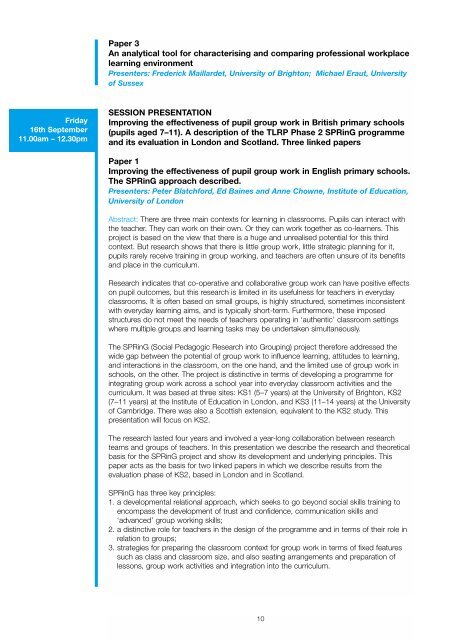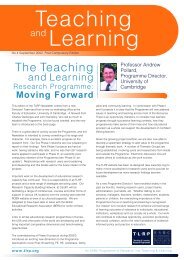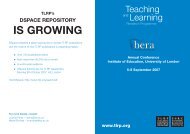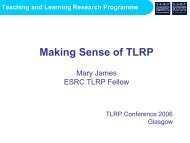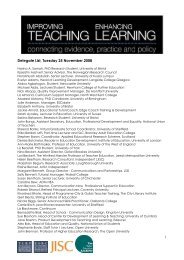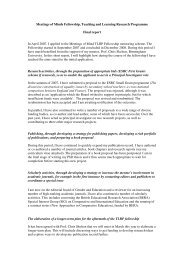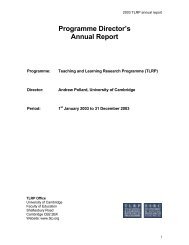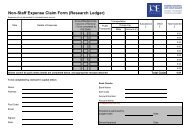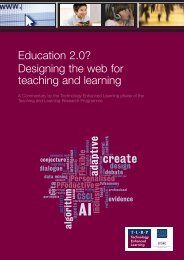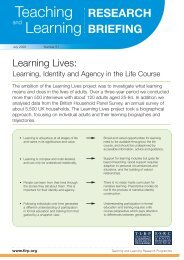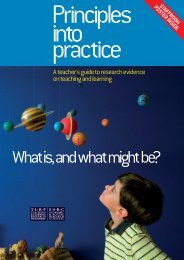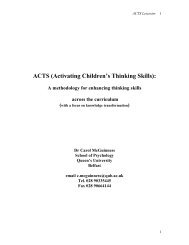Bera Booklet 2005 - Teaching and Learning Research Programme
Bera Booklet 2005 - Teaching and Learning Research Programme
Bera Booklet 2005 - Teaching and Learning Research Programme
- No tags were found...
Create successful ePaper yourself
Turn your PDF publications into a flip-book with our unique Google optimized e-Paper software.
Paper 3An analytical tool for characterising <strong>and</strong> comparing professional workplacelearning environmentPresenters: Frederick Maillardet, University of Brighton; Michael Eraut, Universityof SussexFriday16th September11.00am – 12.30pmSESSION PRESENTATIONImproving the effectiveness of pupil group work in British primary schools(pupils aged 7–11). A description of the TLRP Phase 2 SPRinG programme<strong>and</strong> its evaluation in London <strong>and</strong> Scotl<strong>and</strong>. Three linked papersPaper 1Improving the effectiveness of pupil group work in English primary schools.The SPRinG approach described.Presenters: Peter Blatchford, Ed Baines <strong>and</strong> Anne Chowne, Institute of Education,University of LondonAbstract: There are three main contexts for learning in classrooms. Pupils can interact withthe teacher. They can work on their own. Or they can work together as co-learners. Thisproject is based on the view that there is a huge <strong>and</strong> unrealised potential for this thirdcontext. But research shows that there is little group work, little strategic planning for it,pupils rarely receive training in group working, <strong>and</strong> teachers are often unsure of its benefits<strong>and</strong> place in the curriculum.<strong>Research</strong> indicates that co-operative <strong>and</strong> collaborative group work can have positive effectson pupil outcomes, but this research is limited in its usefulness for teachers in everydayclassrooms. It is often based on small groups, is highly structured, sometimes inconsistentwith everyday learning aims, <strong>and</strong> is typically short-term. Furthermore, these imposedstructures do not meet the needs of teachers operating in ‘authentic’ classroom settingswhere multiple groups <strong>and</strong> learning tasks may be undertaken simultaneously.The SPRinG (Social Pedagogic <strong>Research</strong> into Grouping) project therefore addressed thewide gap between the potential of group work to influence learning, attitudes to learning,<strong>and</strong> interactions in the classroom, on the one h<strong>and</strong>, <strong>and</strong> the limited use of group work inschools, on the other. The project is distinctive in terms of developing a programme forintegrating group work across a school year into everyday classroom activities <strong>and</strong> thecurriculum. It was based at three sites: KS1 (5–7 years) at the University of Brighton, KS2(7–11 years) at the Institute of Education in London, <strong>and</strong> KS3 (11–14 years) at the Universityof Cambridge. There was also a Scottish extension, equivalent to the KS2 study. Thispresentation will focus on KS2.The research lasted four years <strong>and</strong> involved a year-long collaboration between researchteams <strong>and</strong> groups of teachers. In this presentation we describe the research <strong>and</strong> theoreticalbasis for the SPRinG project <strong>and</strong> show its development <strong>and</strong> underlying principles. Thispaper acts as the basis for two linked papers in which we describe results from theevaluation phase of KS2, based in London <strong>and</strong> in Scotl<strong>and</strong>.SPRinG has three key principles:1. a developmental relational approach, which seeks to go beyond social skills training toencompass the development of trust <strong>and</strong> confidence, communication skills <strong>and</strong>‘advanced’ group working skills;2. a distinctive role for teachers in the design of the programme <strong>and</strong> in terms of their role inrelation to groups;3. strategies for preparing the classroom context for group work in terms of fixed featuressuch as class <strong>and</strong> classroom size, <strong>and</strong> also seating arrangements <strong>and</strong> preparation oflessons, group work activities <strong>and</strong> integration into the curriculum.10


